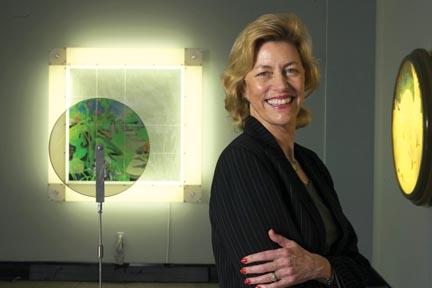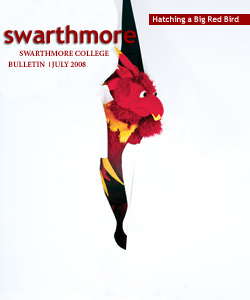The Art of Polage
Austine Wood Comarow ’63 creates a palette of pure light colors with clear cellophane and polarizing filters
Imagine brilliantly colored artwork made with absolutely no pigment. Or painting with light to create a work of art in which each piece is painstakingly hand cut and placed. This is the art of Polage®—a unique concept of polarized light collages described by a term coined from the words “polarize” and “collage.” Using cellophane and polarizing filters, Austine Wood Comarow ’63 invented Polage 41 years ago.
“I always liked experimenting with nontraditional art supplies and had a scientific curiosity about how they behaved,” Comarow says. “Cellophane fascinated me because of the way it catches light and becomes pearly when you build up many layers.” (Cellophane is the traditional name for clear cellulose.) She also liked to draw. The two interests led her to create Polage.
In 1967, she began experimenting with polarizing filters. “Just as a prism breaks white light into a rainbow, simple layers of colorless cellophane sandwiched between transparent polarizing filters magically use light to conjure the most beautiful vibrant colors,” she says. “Most exciting was the idea that I could easily cut and layer these materials to create images—a more science-minded way to work than purely artistic.”
According to James Mann, curator-at-large for the Las Vegas Art Museum and author of the book Austine Wood Comarow: Paintings in Polarized Light, Comarow’s revolutionary paintings challenge the viewer’s perceptive capacity. “By capitalizing upon a single, specific scientific insight,” he says, “Austine has harnessed, controlled, and manipulated the self-invented medium into an esthetically captivating visual phenomena.”
Most creative early in the day, the Las Vegas resident is up at dawn. She begins each project by making a line drawing of the design on tracing paper—most often images of nature. “When I put human figures in my work,” she says, “they are usually abstract.”
Working at a light table covered with a sheet of polarizing filter and the line drawing beneath the work as a guide, Comarow uses an X-Acto knife to cut out hundreds of tiny colorless cellophane shapes with which she recreates the design that will have rich detail and subtle gradations of color and shading when complete. She wears polarizing sunglasses as she works “in order to see the colors of the design, which are colorless until completed, and to have my hands free for manipulating and cutting the cellophane.” She controls the color by the thickness and orientation of the pieces. When the design is complete, a second polarizing sheet is laid over it so the colors can be seen without the sunglasses.
Some of the finished Polages incorporate motorized light boxes that rotate the light beams in response to a series of electronic signals, giving viewers a continuous flow of imagery. Realizing that the most exciting part of working with these materials is the way they are affected by a viewer’s movements, Comarow provides individual filters for some of her pieces so viewers can experience many images and color combinations. She prefers the interactive versions of Polage (with individual filters) because they offer viewers a more participatory experience.
The multitude of images and color combinations surprises observers who encounter her work. “It has a magical effect that elicits exclamations of surprise and delight from anyone who experiences it,” she says.
An example is the Polage Living in Harmony (see www.austine.com). As the polarizing filter rotates, fluid hummingbirds hovering above colorful flowers gently morph into two human faces echoing each other in a continuous flow of imagery.
Comarow’s Polages are in homes and offices; museums and science centers commission them for public spaces. Her work is on display in museums all over the world, including La Cité des Sciences et de l’Industrie, Paris; Technorama, Switzerland; Singapore Science Center; and Disney’s EPCOT Center in Orlando, Fla. Her next major show—a retrospective—will be held at Lakeview Museum of Arts and Sciences in Peoria, Ill., beginning on March 27, 2009.
Of her commissioned works, Comarow is most proud of Human Connections, a 25-foot by 27-foot Polage in The Boston Museum of Science, which has been viewed by Edwin Land, inventor of the polarizing filter.
Comarow remains the sole practitioner of Polage—a visual art form for the 21st century that never fails to captivate viewers.
 Email This Page
Email This Page
